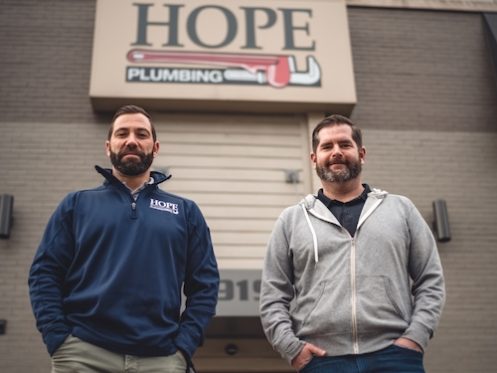Your home’s plumbing and sewer systems are incredibly complex and consist of a large number of components. Knowing the names of these components and what they do is important for helping you understand more about how your plumbing and sewer system work and also for identifying certain issues. With that in mind, here is a quick guide to some of the most important plumbing terms every homeowner should know.
Plumbing Stack
The plumbing stack is the main part of the sewer system inside your home. It is a long pipe that extends just above the roof and runs vertically down through the entire building to where it meets the main sewer line underneath the foundation. The plumbing stack is the technical term for the entire length of pipe, but most plumbers refer to the three different parts of the stack individually.
The uppermost part is the vent stack, which runs up into the attic through a wall in the top floor of the building. It extends at least one foot above the roof. The vent stack serves two very important purposes. The first is to allow all of the sewer gas that forms in a sewer system to be vented outside the building. The other function is to allow air to be pulled into your sewer system any time you flush a toilet or put water down a drain, which is essential for ensuring water and waste drain properly. If no air was drawn in, a vacuum would form in the pipes, and the water would become trapped and not drain away as it should.
The middle part of the plumbing stack is referred to as the drain stack, and this is what the drain pipes from all of the sinks, showers, toilets, and other fixtures drain into. The pipes leading from all of the plumbing fixtures are known as branch drain lines. They run horizontally at a slight downward angle and eventually connect and drain into the drain stack.
The lower part of the plumbing stack is called the soil stack, and this is the part of the stack that extends through the basement floor or crawl space. The soil stack then connects to the main sewer line underneath the building’s foundation.
Sewer Cleanout
The sewer cleanout is another essential part of modern sewer systems, but it’s not something you always find on older homes that still have a cast iron or clay sewer line. Sewer cleanouts are usually located near the foundation, just above the sewer line, but they can also sometimes be out near the edge of the yard. Some homes only have a single cleanout, but most newer buildings will have two cleanouts located a short distance from each other.
A cleanout is simply a piece of PVC pipe that extends above the ground and is connected to the sewer line below the ground. The purpose of sewer cleanouts is to allow direct access to the main sewer line so that clogs and tree roots can be cleaned out of the pipe more easily using a plumber’s snake, rooting machine, or hydro jetting machine.
If the home doesn’t have a cleanout, the only way to access the sewer line is to either go up on the roof and go in through the vent stack or to remove a toilet and go in through the drain stack via a branch drain line. This is obviously much more difficult than accessing the sewer line through a cleanout, which is why we’d definitely recommend having cleanouts installed if your house doesn’t have them.
P-Trap
A P-trap is something you will find underneath your kitchen sink, bathroom sink, and other drains. If you look below your kitchen sink, you’ll see where the drain pipe that extends beneath the sink connects to a horizontal pipe with a bend or belly in it. This is the P-trap, and it gets its name because this bend makes it somewhat resemble the letter P.
The main purpose of a P-trap is to prevent noxious sewer gases from being able to flow back up through the drain pipe and out of the drain. The pipe is designed so that water is always trapped in the bend or belly, which creates a barrier that traps the sewer gases in the drain pipe.
There are times when strong winds can blow down through the vent stack and force the water out of the P-trap. If you don’t use a sink or other drain for a few days or weeks, the water in the trap can also evaporate. If you ever smell a strong sewage odor emanating from a drain, it typically means that the P-trap is empty and needs to be refilled by putting a bit of water down the drain so that the sewer gases are again trapped.
Toilet Flapper
If you look inside a toilet tank, you will see a round piece of rubber at the bottom of the tank that’s connected to a long chain. This is the toilet flapper, which works to seal the tank so that water can’t leak out into the toilet bowl. Whenever you flush the toilet, the flush arm raises the chain and lifts the flapper so that much of the water in the tank rushes out to flush the bowl. Whenever you have a toilet that frequently runs and refills when not in use, it is often because the flapper is worn out and no longer creates a watertight seal between the tank and the bowl.
T&P Valve
The temperature and pressure release valve, or T&P valve, is an essential safety feature found on all tank-type water heaters, and it works to ensure that the pressure inside the tank never rises above a specific level. Water heaters can sometimes malfunction and heat the water in the tank to a much higher temperature than it should be. As the temperature increases, the pressure in the tank also increases, which could potentially lead to the tank exploding. The T&P valve ensures that this can’t ever happen. Any time the pressure rises above a certain point, it forces the valve open so that some water drains out and the pressure instantly decreases.
Backflow Valve
Backflow valves, or backflow prevention devices, are designed to prevent water from flowing through a pipe in the wrong direction. In most cases, this is intended to prevent potentially contaminated gray water from mixing with the clean water supply. All dishwashers have a type of backflow valve known as an air gap valve, which works to ensure the dirty dishwater can’t ever mix with the clean water supply.
Most plumbers also recommend installing a type of backflow valve known as an atmospheric vacuum breaker (AVB) on all of your outdoor hose bibs. The supply line that feeds a hose bib can sometimes lose pressure and lead to water siphoning back up through the hose and into the water supply. This is obviously an issue, as it could contaminate the water supply with mud, fertilizer, etc. An AVB works to ensure that this back siphoning can’t ever occur.
You can also have a special type of backflow preventer installed in your main sewer line. This type of valve is essentially a door or gate that can open and close. All of the wastewater from the plumbing system will just flow over the valve. However, if waste starts to flow back up the sewer line due to a clog or any other issue, it will push up against the valve so that it closes to prevent sewage from backing up inside the home. Not all homes have sewer backflow preventers, but this is another thing we would definitely recommend installing if your home doesn’t have one.
If you’re in need of an honest, experienced plumbing company in Indianapolis, Hope Plumbing is your number one choice. We specialize in all types of residential plumbing repairs, and we can also assist if you need leak detection, drain cleaning, or any sewer services. Contact us today to get any of your plumbing needs taken care of promptly and professionally.

